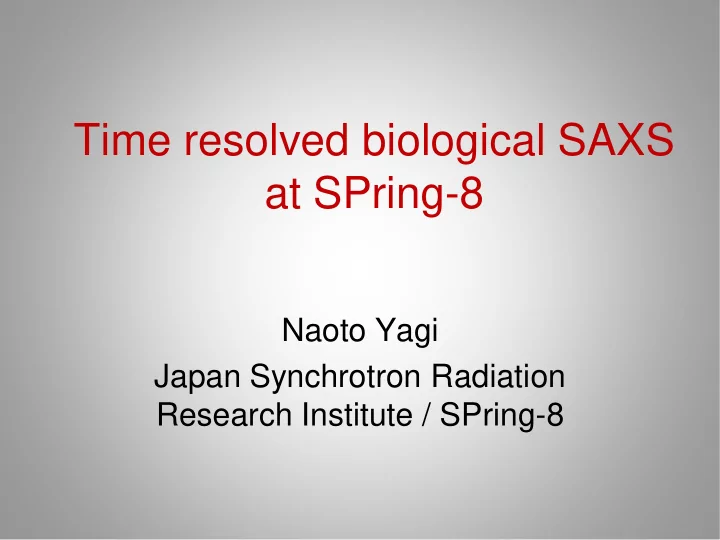

Time resolved biological SAXS at SPring-8 Naoto Yagi Japan Synchrotron Radiation Research Institute / SPring-8
SPring-8 The biggest (circumference 1.4km) synchrotron radiation facility The highest ring energy (8 GeV) 53 beamlines in operation
Methods of time-resolved experiments Time resolution is limited by the detector. time • Continuous recording X-ray Photon Correlation Spectroscopy 0 1 2 3 time • Pump-probe τ X-ray Free Electron Laser Repeat the experiment changing τ . pump probe by by X-ray The experiment need to be laser repeatable on the same sample.
Classification of detectors • Photon counting Geiger counter, Pilatus, solid state detector • Integrating film, image plate, CCD, ionization chamber
BL40XU High flux beamline Beamline: Helical undulator + KB-mirrors (“pink beam”: bandwidth ~2%) 1 × 10 15 cps@12.4keV Flux: 200(H) × 40(V) µ m Beam size: Energy: 8 - 16 keV Camera length: up to 3 m Detectors: High-speed X-II + CCD/CMOS etc. Applications: Time-resolved studies on muscle, microbeam diffraction, protein dynamics, XPCS
Beam profile size : 200 µ m (H) × 40 µ m (V) flux : 6.5 × 10 14 photons/sec (@8 keV) 9.0 × 10 14 photons/sec (@10 keV) 3.0 × 10 15 photons/sec (@11.5 keV) 1.0 × 10 15 photons/sec (@12.4 keV) 6.0 × 10 14 photons/sec (@15 keV) flux density : ~1 × 10 17 photons/sec/mm 2 front end slit : 0.5mm (H) × 0.165mm (V)
Blue light
Burning a paper
Boiling water
Ca-regulation of contraction Muscle contraction is regulated by intracellular calcium. Ca 2+ binding to troponin molecule on the thin filament allows interaction between actin and myosin, and then muscle contraction takes place. In this study, Ca 2+ binding to troponin in live frog muscle was monitored by Small-Angle X-ray Diffraction (SAXD). SAXD is a unique method measuring the structural changes of contractile and regulatory proteins in live muscle. The troponin-related reflection intensity is measured in the SAXD patterns.
Experimental Setup for Muscle Diffraction Experiment at BL40XU@SPring-8 motor for muscle length control electrical stimulation cooling water IN skeletal muscle windows for X-rays cooling water OUT force transducer X-rays vacuum path X-ray detector solenoid shutter vertical translation: 100mm/sec
Radiation damage in SAXS “Radiation damage to a protein solution, detected by synchrotron X-ray small-angle scattering: dose-related considerations and suppression by cryoprotectants” S. Kuwamoto, S. Akiyama and T. Fujisawa J. Synchrotron Rad. (2004). 11 , 462-468 • Serious problem at 3rd generation synchrotrons • Flux density matters! • Due to oxidation of protein molecules by radicals • Depends on the protein • Aggregation --- increase of scatter in small-angles • DTT, glycerol, sucrose may help • Moving the sample during exposure helps
Control of caged-ATP experiment Wakayama, J., T. Tamura, N. Yagi and H. Iwamoto. Biophys. J. 87 , 430-441 (2004)
Fast CCD camera • 290 frames/sec (90 M-pixels/sec) • 640 × 480 pixels Yagi, N., K. Inoue and • 10-bit ADC T. Oka. J. Synchrotron Rad. , 11 , • 4 GB frame memory 456-461 (2004)
Muscle diffraction experiment at BL40XU using an X-ray image intensifier and a fast CCD camera 0.52 msec (640 × 72 pixels) 3.4 msec (640 × 480 pixels) sfrog10a_143 sfrog10a_143 5 10 4 4 10 4 Integrated intensity 3 10 4 2 10 4 1 10 4 0 0 10 20 30 40 50 60 70 Frame number
High-speed CMOS camera
Skeletal muscle contraction @1ms
X-ray diffraction from skeletal muscle resting contracting myosin meridional actin layer-lines reflections 6th 5th 2nd 4th 3rd 2nd 1st
Troponin reflections 6 5 troponin 4 3rd myosin meridional reflections reflection (at d=14.3nm) 3rd 2 Troponin reflection at 38.5nm 2nd and C-protein reflection at 44.1nm 1st
Comparison of time courses 38.5nm 0 ℃ electrical stimulus
Measurement of Ca 2+ Experiments were made at BL40XU in SPring-8 (Hyogo, Japan). SAXD measurements X-ray X-ray 1st slit vacuum path X-II CCD 2nd slit (~2800mm) specimen detector Hg lamp Fluo3 measurements specimen PC Fluo 3-AM Photomultiplier specimen Experimental Conditions Specimen: Semitendinosus muscle (SL:2.8µm) of bullfrog Temperature: 16ºC Time resolution: 1msec (Small-angle X-ray diffraction), 0.5ms (fluorescence) Condition: Single pulse or double pulse (interval of 15msec) Ca-indicator: fluo3-AM The SAXD and fluorescence from fluo3 were recorded in the same specimen alternately.
Calcium signals
Comparison of the time courses 16 ºC stimulus
Comparison of the time courses • Troponin intensity increases more slowly than Ca- binding ==> Cooperativity in the thin filament • Troponin intensity decays when tension begins to develop ==> Myosin binding to actin affects troponin conformation. Matsuo, T., H. Iwamoto and N. Yagi. Biophys. J. 99 , 193-200 (2010)
Bacteriorhodopsin “Structural Transition of Bacteriorhodopsin Is Preceded by Deprotonation of Schiff Base: Microsecond Time-Resolved X-Ray Diffraction Study of Purple Membrane“ T. Oka, K. Inoue, M. Kataoka and N. Yagi Biophys. J. 88 , 436-442 (2005).
Bacteriorhodopsin
Proton pumping
Diffraction from purple membrane
Shutter system
Intensity changes
Comparison of time courses deprotonation of the Schiff base precedes the structural change around the G-helix. SVD (Singular Value Decomposition)
Projected electron density map of BR A A B C G D F E A
Akiyama et al. PNAS 99 ,1329-1334 (2002) CTF (continuous flow) 0.5-15msec STF (stopped- flow) BL45XU
folding of cytochrome c 160us
analysis of intermediates Kratky plot 2400/s Unfolded ↔ I → II → Native 68/s → 12500/s ← 2000/s Reconstructed scattering N II profiles for the three kinetic components observed I during the folding of cyt c.
Pair distribution functions N I II
BL44B2 Single-molecule tracking white or pink Motion of KcsA potassium channel revealed by single molecule tracking (Shimizu et al., Cell 2008)
pH 7.5 not gating pH 4.0 gating
Time ranges of protein motions psec nsec µsec msec sec local changes size scale chain conformation domain movement larger changes (diffusion) crystallography SAXS
Thank you for your attention.
Recommend
More recommend